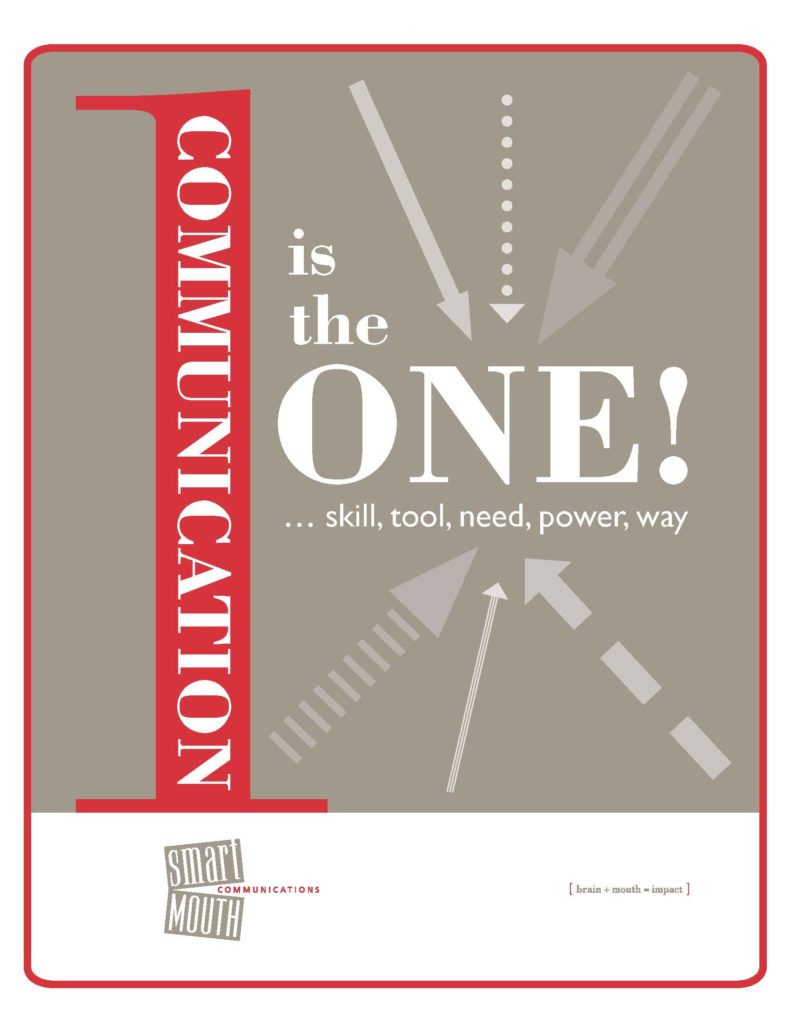by Beth Levine | Dec 17, 2021 | smartmouth talks!
Here we are at the end of 2021. Cheers to all of us! We’ve been in person, virtual, working, resigning, working from home, returning to offices, and a hybrid of all of the above. We’ve seen normal, new normal, and the next normal. Adapting to change seems to be the one constant.
But it’s not.
The one constant is Communication. Communication is the one superpower that can handle anything! In fact, I may be biased, but I would suggest that the people and the organizations who value communication the most and execute on it the best are poised to be more successful and better prepared for whatever comes our way in the new year.
As we reflect on this past year and look to 2022, let’s put Communication at #1. It’s the one thing we all need.
Happy Holidays!


by Beth Levine | Oct 12, 2021 | public speaking
 It doesn’t take much to be a good leader-communicator. Perfection may be elusive, but being good enough to earn the admiration of your team are well within reach. Adherence to a few core principles takes care of most situations.
It doesn’t take much to be a good leader-communicator. Perfection may be elusive, but being good enough to earn the admiration of your team are well within reach. Adherence to a few core principles takes care of most situations.
In my book Jock Talk: 5 Communication Principles for Leaders as Exemplified by Legends of the Sports World, I walk readers through the philosophy behind, and application of, these 5 principles: Audience-centricity, Transparency, Graciousness, Brevity, and Preparedness.
Taken together, they send two really important messages about you to your audience: 1) that you care about and respect them, and 2) that you’re real and therefore credible and trustworthy.
Audience-centricity is probably the most fundamental of the five principles. Simply put, audience-centricity is making the audience’s interests and experience a top priority in the planning and execution of a talk. Too many speakers prepare and deliver what is important and interesting to themselves without enough careful consideration of their listeners. Being audience-centric is a mindset shift that encourages the speaker to prepare and deliver content in a way that will matter to and resonate with the audience.
Transparency is exactly what you think it is; it’s about being open and direct—yes, and honest, too. Transparency is critical. It contributes to the levels of sincerity and trust that are accorded to you by your audience.
Graciousness is the art, skill, and willingness to be kindhearted, fair, and polite. As motivators and influencers, love and peace work far better than hate and war. Speaking in positives rather than negatives leaves lasting, favorable impressions.
Brevity is a crowd-pleaser and needs no further introduction.
Preparedness speaks for itself as well, especially because the unprepared speaker is the one who is most likely to be longwinded, not to mention unfocused. While the mere thought of preparation might bring on feelings of dread or even impossibility, there are ways to prepare that take only seconds but that can greatly enhance a speaker’s effectiveness.
As you settle in for the homestretch toward year-end, I would encourage you to pick one of these principles as your personal pet project for the remainder of Q4. Which one of these 5 do you feel like you need to improve on the most? Or which one of these 5 would have the most impact on your business if you strengthened it? Pick one and go for it!
by Beth Levine | Sep 18, 2021 | preparing for a presentation, procrastination, public speaking
Three Tips to Overcome Public Speaking Nerves
 Do you get nervous about speaking in public? Sometimes? Always? Let’s see what we’re even talking about here.
Do you get nervous about speaking in public? Sometimes? Always? Let’s see what we’re even talking about here.
One way Webster’s Dictionary describes nerves is “marked by strength of thought, feeling, or style: spirited.” That doesn’t sound like such a bad thing, does it? I think it sounds kind of promising. And that’s exactly the point.
Nervous energy is not negative energy. It’s positive. It’s your body’s adrenaline getting you ready to do a killer job. You just have to embrace it and understand it is a natural part of the experience.
The good news about the adrenaline rush you feel at the beginning of your talk
– even if it’s making you short on breath or sick to your stomach – is that it’s going to level off. There is research as well as anecdotal evidence that nervousness fades in the first two minutes.
So, here are 3 tips for you for those first 120 seconds:
1. Accept, rather than resist, that your nerves will come with you to the front of the room – kind of like a constant companion. And know that they’ll begin to dissolve in a matter of seconds.
2. Choreograph your opening in a way that allows you to share the floor with your audience and gives you a chance to inhale and exhale – and maybe even relax a wee bit. One example of this is opening with a question for the audience and soliciting some input from them. Engaging the audience takes pressure off you and gives you a feeling of control that helps your nerves dissipate more quickly.
3. Even if you don’t have a lot of time for rehearsing, set aside a little time to practice your opening. If you are familiar and comfortable with your opening, and you practice delivering it in a deliberately slow manner, you just might be able to compensate for the adrenaline that makes you flustered and that makes you speed talk.
Nerves happen. They’re natural. They’re energy. And they’re temporary.
by Beth Levine | Aug 23, 2021 | preparing for a presentation, public speaking
 “Go right up to that line but don’t cross it,” I say. My client, rehearsing her speech for me, says, “Okay, let me give it another try.”
“Go right up to that line but don’t cross it,” I say. My client, rehearsing her speech for me, says, “Okay, let me give it another try.”
The line I’m referring to is the invisible but instinctive line between what’s barely comfortable and what’s not when employing theatrics to enhance your delivery.
Don’t let the word theatrics throw you off or cause you to self-select out of reading any further. Presentation theatrics are necessary, they animate you and your content. Theatrics are the energy – voice and body – that you infuse into your delivery. They should produce a delivery that feels a bit exaggerated to you but simply comes off as energetic to your audience.
To achieve that energetic connection with your audiences, here are some tips for your voice, hands and body:
Voice. In a word, modulate. Vary and adjust your speaking pace, volume, pitch. For example, if there is a section of your speech that should sound more conversational, then you can speak at a quicker pace and with a normal tone of voice. If you have a word, phrase or sentence that warrants attention, you will want to slow down, project your voice, and essentially emphasize it orally as you would if you were writing it in boldface font.
Hands. Use them as props in your play. Think Charades. You can literally animate your speech by using gestures that go with your words. For example, to welcome your audience or when talking about “all of us here in this room,” use outstretched arms to make a large, open embrace. If you are talking about something personal or touching or emotional, put your hands to your heart. You can clap (yes!), punch your fist in the air (victory!), offer an exaggerated shrug (who knew?!), put the back of your hand to your forehead (ugh!). Talking with your hands is a-okay.
Body. Unless you are forced to stand behind a podium due to a fixed microphone, you want to use your body also. Nothing distracting (like pacing), but some movement across the floor or stage helps to keep your audience’s attention. For example, if you’re talking about making a change or a move, literally walk a few feet across the floor. Move to get closer to different sides or sections of the room. Take a giant step forward to illustrate progress or a step backward to illustrate a setback. Act out your words.
Regardless of how you animate your speech and which tactics you use, just know that you will be pushing yourself and using your whole body, head to toe. Keep it authentically you, but an exaggerated you. Push it to the point where you feel like you’re putting on a show … because you are.
by Beth Levine | Jun 28, 2021 | Just Mouthing Off, preparing for a presentation, public speaking
 When will you know you’re good? Maybe never. And that’s a good thing.
When will you know you’re good? Maybe never. And that’s a good thing.
You can be a highly confident, highly competent speaker and still not be as good as you want to be or think you should be. And that’s really a good thing.
Why? Because it keeps you on your toes. That’s the simple answer. You want to be on your toes for every audience. Once you think you’ve arrived, or that you’re good enough, you’ll get complacent and, trust me, it’ll show. Audiences will pick up on it. Just by the very nature of audiences – that each one is different – you are earning your stripes each time you get up to speak.
Being a good public speaker is a journey in which the endpoint is always moving and changing. You want it that way. You want to work at it, strive for it, and sweat it out.
If you’re like I am and you try to stay on your toes, then how else do you continue the journey to greatness as a speaker? The best coaching you can get, and the best way to get closer to that greatness, is to listen to audience feedback. Ask for it anecdotally or through evaluation forms, and then do something with it. Feedback is the GPS for your journey, be sure to pay attention to it!
So, when will you know you’re good? When you get to a point where you actually crave feedback, where you look for ways to adapt and improve all the time. Then I’d say you’re pretty darn good!



 It doesn’t take much to be a good leader-communicator. Perfection may be elusive, but being good enough to earn the admiration of your team are well within reach. Adherence to a few core principles takes care of most situations.
It doesn’t take much to be a good leader-communicator. Perfection may be elusive, but being good enough to earn the admiration of your team are well within reach. Adherence to a few core principles takes care of most situations. Do you get nervous about speaking in public? Sometimes? Always? Let’s see what we’re even talking about here.
Do you get nervous about speaking in public? Sometimes? Always? Let’s see what we’re even talking about here. “Go right up to that line but don’t cross it,” I say. My client, rehearsing her speech for me, says, “Okay, let me give it another try.”
“Go right up to that line but don’t cross it,” I say. My client, rehearsing her speech for me, says, “Okay, let me give it another try.” When will you know you’re good? Maybe never. And that’s a good thing.
When will you know you’re good? Maybe never. And that’s a good thing.

